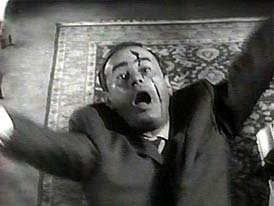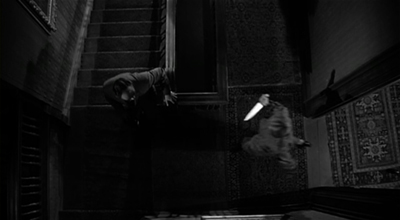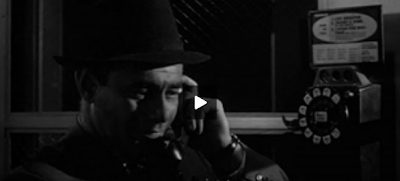The extract I chose occurs 1hr 12min 14sec into the film. At this point in the film we see Arbogast has just integrated Mr.Bates and he is now entering a telephone booth where he calls Leila to tell her that he will further spend more time looking into Mr.Bates. Arbogast then goes back to the Bate's Hotel where he is murdered.
In this extract there is only one character that is focused on, this is detective Arbogast. In this section of the film, detective Arbogast is represented as being as a minor character that propels the plot through his murder and leading the audience into the development of Mr.Bates's mother. Furthermore Arbogast is a static character that allows the audience to see how ruthless the murderer is, which who at this point in the film the viewer believes is Norman Bates's psychotic mother. The spotlight was not on Arbogast until this moment in the film because Arbogast's role is seen more of a rise in action then he is an actual character, for this reason the audience does not fell much sympathy when he is killed. For example there is much more despair when Marion is killed then their is when Arbogast is even when he is depicted as an innocent man seeking for the truth. After his death(not in the extract) their is development in plot when Sam and Lila go to the police and they find out that Norman's mother is dead. The audience is now put on the edge of their seat, however this suspense was caused by Arbogast's murder, without it Lila and Sam would have never discovered this information and went to the hotel to see for themselves
Arbogast's style of acting is very normal and acts as a common male detective. Arbogast does not have a unique style of acting because this would distract the audience and take away from the main points of the plot. For example if Arbogast was a very likable character the audience would feel sympathy and this would take away attentions from Marion's murder. Or if Arbogast was an unliked or malicious character the audience would believe he deserved his horrific ending, this would also take away from the mother's compulsive killing and would some what justify it.There is a lot of dramatic irony as he slowly walks up the stairs to the Bate's home, the audience acknowledges how much danger he is in, but Arbogast himself is completely clueless as he takes another step to his death. In addition the murderer's acting, who the audiences believes is the mother, is very forceful and vicious when she is attacking Arbogast, she never hesitates, this further pushes the idea of how violent and insane the she really is.
 The overall extract is shot in a formalistic style. In the first scene of the extract Arbogast is in a telephone booth. Arbogast is the main focus during this time in the film and for this reason he falls on the rule of thirds in this scene to the left and almost all of the others. This fast fall off creates more interesting shot as Arbogast tells Lila that Bates's mother might have had something to do with Marion's disappearance. Arbogast is correct, but he doesn't know that this impact was the extent of murder and this is why the scene is set in more of a dramatic way because his words are true but ignorant .In addition when Arbogast goes back to the Bates's Motel, their is slow pacing within the shots as they build up to his murder. This consist of several extreme long shots of Arbogast walking around the Bates Hotel and walking up to the Bates's home. All the shots of Arbogast before he is killed are held for a very long time. The shots prior to Arbogast's murder keep the audience on the edge of their seats as he gradually and painfully walks to the home. Shots finally pull in closer to a medium close-up a minute before Arbogast's murder as he walks into the house and starts walking up the stairs. One of the shots that also adds to the slow pacing prior to his murder, is when Arbogast is slowly walking up the stairs. Their is a full shot and close up of his feet climbing the stairs. The audience truly knows that Arbogast is in danger as he is getting closer to the murderer. The audience is able to focus on him and his last seconds in the film before he is killed. The shot that follows this is even more important, it is of a door calmly opening.This shot captivates the audience because at this point it is appallingly obvious that Arbogast is going to die because it assumed that the murderer is about to strike.
The overall extract is shot in a formalistic style. In the first scene of the extract Arbogast is in a telephone booth. Arbogast is the main focus during this time in the film and for this reason he falls on the rule of thirds in this scene to the left and almost all of the others. This fast fall off creates more interesting shot as Arbogast tells Lila that Bates's mother might have had something to do with Marion's disappearance. Arbogast is correct, but he doesn't know that this impact was the extent of murder and this is why the scene is set in more of a dramatic way because his words are true but ignorant .In addition when Arbogast goes back to the Bates's Motel, their is slow pacing within the shots as they build up to his murder. This consist of several extreme long shots of Arbogast walking around the Bates Hotel and walking up to the Bates's home. All the shots of Arbogast before he is killed are held for a very long time. The shots prior to Arbogast's murder keep the audience on the edge of their seats as he gradually and painfully walks to the home. Shots finally pull in closer to a medium close-up a minute before Arbogast's murder as he walks into the house and starts walking up the stairs. One of the shots that also adds to the slow pacing prior to his murder, is when Arbogast is slowly walking up the stairs. Their is a full shot and close up of his feet climbing the stairs. The audience truly knows that Arbogast is in danger as he is getting closer to the murderer. The audience is able to focus on him and his last seconds in the film before he is killed. The shot that follows this is even more important, it is of a door calmly opening.This shot captivates the audience because at this point it is appallingly obvious that Arbogast is going to die because it assumed that the murderer is about to strike. 


 The next shot, is high angled, which captivates most of Arbogast's attack. This is one of the few shots that the audience is able to see of the murderer. The attack is shown from only a few shots in order to conceal the face of the murderer which aids in the film's amazing climax when the murderer is revealed. This shot is well set up. We see both characters and the knife that the murderer is holding, it is fully visible and is clear that Arbogast has been caught by surprise and will be killed. Lastly one of the significant camera movements in this scene is when Arbogast is falling down the stairs and camera follows his fall. His arms are flaring and his face is covered in blood and conveys terror with his expression.
The next shot, is high angled, which captivates most of Arbogast's attack. This is one of the few shots that the audience is able to see of the murderer. The attack is shown from only a few shots in order to conceal the face of the murderer which aids in the film's amazing climax when the murderer is revealed. This shot is well set up. We see both characters and the knife that the murderer is holding, it is fully visible and is clear that Arbogast has been caught by surprise and will be killed. Lastly one of the significant camera movements in this scene is when Arbogast is falling down the stairs and camera follows his fall. His arms are flaring and his face is covered in blood and conveys terror with his expression.Territorial design is pretty simple, there is a eye line match as Arbogast first walks into the home and he looks at the inside. The scene is kept pretty simple because their needs to be some element of surprise when we see the murderer about to kill Arbogast. For instance if the home was cover in knives or blood it would be too obvious and Arbogast would have probably left the house at that point, but if he unwisely ventured on into the house it would also be obvious that he would be killed.
 The editing of the scene follows Classic Cutting. Before entering the house the cuts are long and slow, however right when Arbogast is about to be murdered we see faster and shorter cuts. One shot of this faster cutting is when the murderer is holding the knife that is about to be stabbed into Arbogast. Lastly most of the shots used for the murder of Arbogast were not used in the final film due to production codes.
The editing of the scene follows Classic Cutting. Before entering the house the cuts are long and slow, however right when Arbogast is about to be murdered we see faster and shorter cuts. One shot of this faster cutting is when the murderer is holding the knife that is about to be stabbed into Arbogast. Lastly most of the shots used for the murder of Arbogast were not used in the final film due to production codes.The scene has relatively a lot of light for a murder scene.Darkness does not conceal the murder's face, but instead cinematography hides the person with the knife who kills Arbogast. Color is not a significant element in this extract because the whole movie is shot in black and white.
As Arbogast walks to the Bates's home dramatic music is played which adds horror and gives the audience an unsettling feeling. This is also the music that is reoccurring in the film, it was played when Marion was killed in the shower and when Bates's mother is revealed as a corpse. These rising actions had all the same song, and this benefited the film. Hitchcock even quoted, "33% of the effect of Psycho was due to the music".
The location of the extract has many interesting aspects due to the character stumbling into his own death when he enters the house of a murderer. It would have been over done if Arbogast's was also killed in the Bate's hotel, the murder would have been to similar to Marion's. An example of mis en scene is the knife, this is purposely used again so the audience can identify that this is the same murder previously seen and the location also allows the audience to assume that this the mother since Arbogast has entered the Bates's house. If it where to be shot outside with another weapon used, the audience would be confused on who is killing the characters.
One of the main symbols in the film that is also portrayed in the extract is the usage birds. When Arbogast first returns to the Bates's Hotel he looks in the office, here there is an eye line match where Arbogast looks at a giant stuffed bird on the wall, he then leaves to walk up to the house. "Stuffing birds" is British slang for sex, bird meaning desirable women, this conveys suppressed sexual desire in the film due to Norman's mother controlling his life. Before Arbogst's dies he sees this symbol, this is significant because Arbogast's figuratively sees the reason for both his death and Marion's through this reoccurring object.


No comments:
Post a Comment